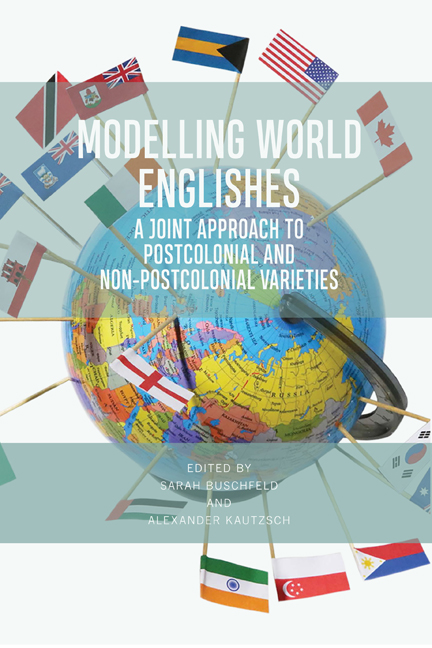Book contents
- Frontmatter
- Contents
- List of Figures and Tables
- List of Contributors
- Foreword
- 1 Introduction
- 2 English in England: The Parent Perspective
- 3 English in Namibia: Multilingualism and Ethnic Variation in the Extra- and Intra-territorial Forces Model
- 4 English in the United Arab Emirates: Status and Functions
- 5 English in India: Global Aspirations, Local Identities at the Grassroots
- 6 English in Singapore: Two Issues for the EIF Model
- 7 English in the Philippines: A Case of Rootedness and Routedness
- 8 English in South Korea: Applying the EIF Model
- 9 English in Japan: The Applicability of the EIF Model
- 10 English in Australia – Extra-territorial Influences
- 11 English in North America: Accounting for its Evolution
- 12 English in The Bahamas and Developmental Models of World Englishes: A Critical Analysis
- 13 Standard English in Trinidad: Multinormativity, Translocality, and Implications for the Dynamic Model and the EIF Model
- 14 Englishes in Tristan da Cunha, St Helena, Bermuda and the Falkland Islands: PCE, non-PCE or both? Blurred Boundaries in the Atlantic
- 15 English in Ireland: Intra-territorial Perspectives on Language Contact
- 16 English in Gibraltar: Applying the EIF Model to English in Non-Postcolonial Overseas Territories
- 17 English in Ghana: Extra- and Intra-territorial Forces in a Developmental Perspective
- 18 Synopsis: Fine-tuning the EIF Model
- Index
16 - English in Gibraltar: Applying the EIF Model to English in Non-Postcolonial Overseas Territories
Published online by Cambridge University Press: 24 September 2020
- Frontmatter
- Contents
- List of Figures and Tables
- List of Contributors
- Foreword
- 1 Introduction
- 2 English in England: The Parent Perspective
- 3 English in Namibia: Multilingualism and Ethnic Variation in the Extra- and Intra-territorial Forces Model
- 4 English in the United Arab Emirates: Status and Functions
- 5 English in India: Global Aspirations, Local Identities at the Grassroots
- 6 English in Singapore: Two Issues for the EIF Model
- 7 English in the Philippines: A Case of Rootedness and Routedness
- 8 English in South Korea: Applying the EIF Model
- 9 English in Japan: The Applicability of the EIF Model
- 10 English in Australia – Extra-territorial Influences
- 11 English in North America: Accounting for its Evolution
- 12 English in The Bahamas and Developmental Models of World Englishes: A Critical Analysis
- 13 Standard English in Trinidad: Multinormativity, Translocality, and Implications for the Dynamic Model and the EIF Model
- 14 Englishes in Tristan da Cunha, St Helena, Bermuda and the Falkland Islands: PCE, non-PCE or both? Blurred Boundaries in the Atlantic
- 15 English in Ireland: Intra-territorial Perspectives on Language Contact
- 16 English in Gibraltar: Applying the EIF Model to English in Non-Postcolonial Overseas Territories
- 17 English in Ghana: Extra- and Intra-territorial Forces in a Developmental Perspective
- 18 Synopsis: Fine-tuning the EIF Model
- Index
Summary
INTRODUCTION
Gibraltar is a British Overseas Territory located at the southern tip of the Iberian Peninsula. As a British territory, English is its official language, although due to the Spanish roots of part of the population, as well as the coexistence of other ethnic groups historically (Maltese, Genoese, Jewish, Moroccans, among the most notable), it has developed a local vernacular language, known as Yanito, which has coexisted with Spanish and English. However, a recent increase in the use of English at home among younger Gibraltarians has been reported (Kellerman 2001: 91–93; Levey 2008: 58, 95–98; Weston 2013) and English is becoming the first language of most Gibraltarians, to the extent that an emerging variety of English appears to be in the process of becoming nativized, labeled Gibraltar English (Kellerman 2001; Levey 2008; Weston 2011), which “carries an identity function for its users” (Weston 2011: 361; see also Levey 2015: 51). The aim of this chapter is to consider how this new variety of English fits within the most influential models of analysis within World Englishes and then to apply the latest model, known as the Extra- and Intra-territorial Forces Model (EIF Model), developed by Buschfeld and Kautzsch (2017). The chapter is structured as follows: section 2 briefly describes the demographic, historical, and sociocultural situation of Gibraltar; section 3 analyzes the status of English in Gibraltar from a historical point of view, as well as the emergence of Gibraltar English, a new variety of English resulting from the language contact situation in Gibraltar; section 4 presents Gibraltar English according to the most influential analytical frameworks of World Englishes; section 5 analyzes the current status and linguistic forms of Gibraltar English from the EIF perspective; finally, section 6 presents some conclusions.
GIBRALTAR: DEMOGRAPHY, HISTORY, AND SOCIOCULTURAL BACKGROUND
Gibraltar is a territory located on the southern coast of the Iberian Peninsula, bordered to the north by Spain. It has an area of almost 7 km2 and a population of 32,194 people (see Figure 16.1), according to the latest census report (Census of Gibraltar 2012), of which 25,111 (78 percent) are considered Gibraltarians, 4,249 (13.2 percent) British, and the remaining 2,501 (7.8 percent) form a heterogeneous group, of which the most numerous are Moroccans (522).
- Type
- Chapter
- Information
- Modelling World EnglishesA Joint Approach to Postcolonial and Non-Postcolonial Varieties, pp. 347 - 370Publisher: Edinburgh University PressPrint publication year: 2020



